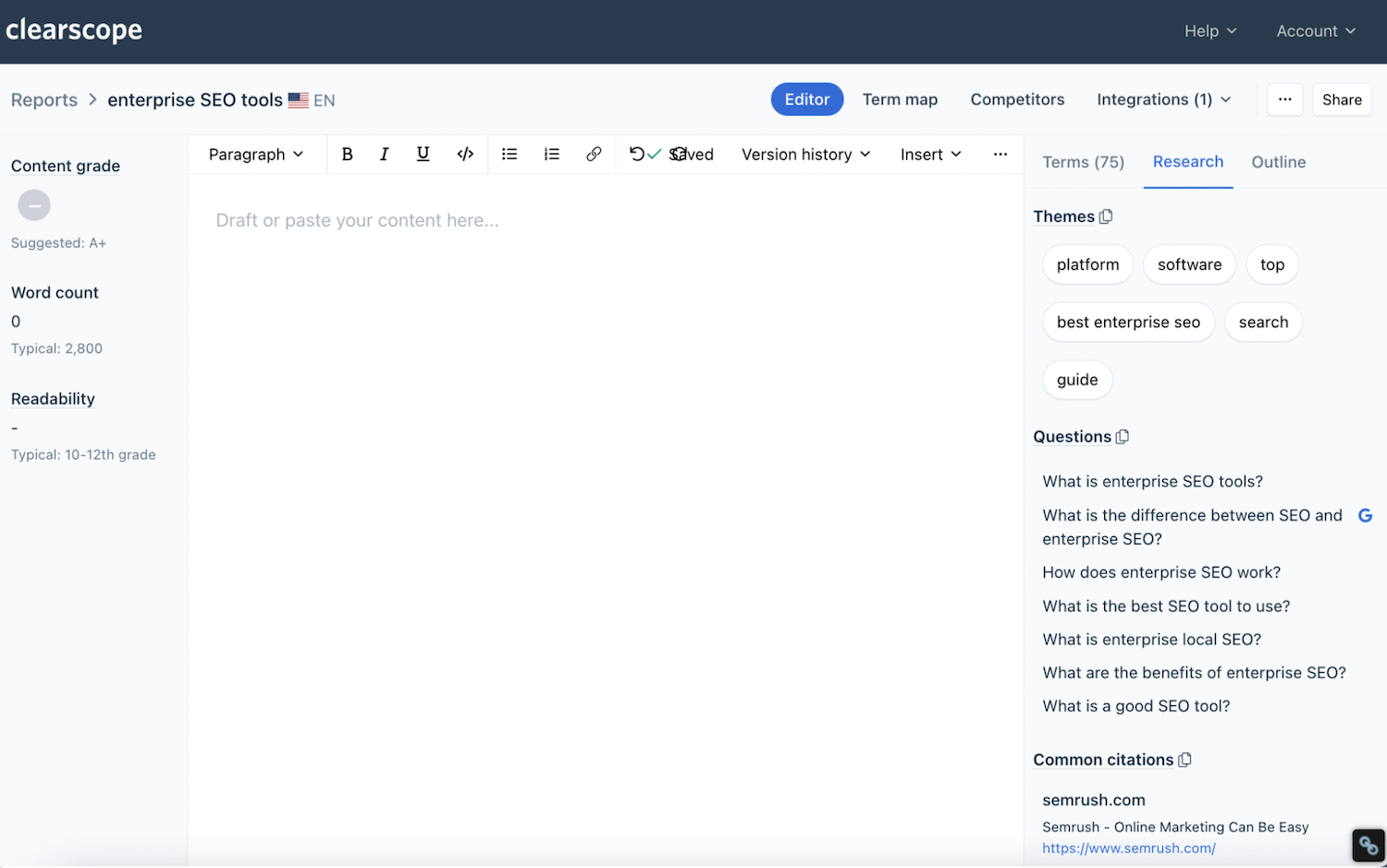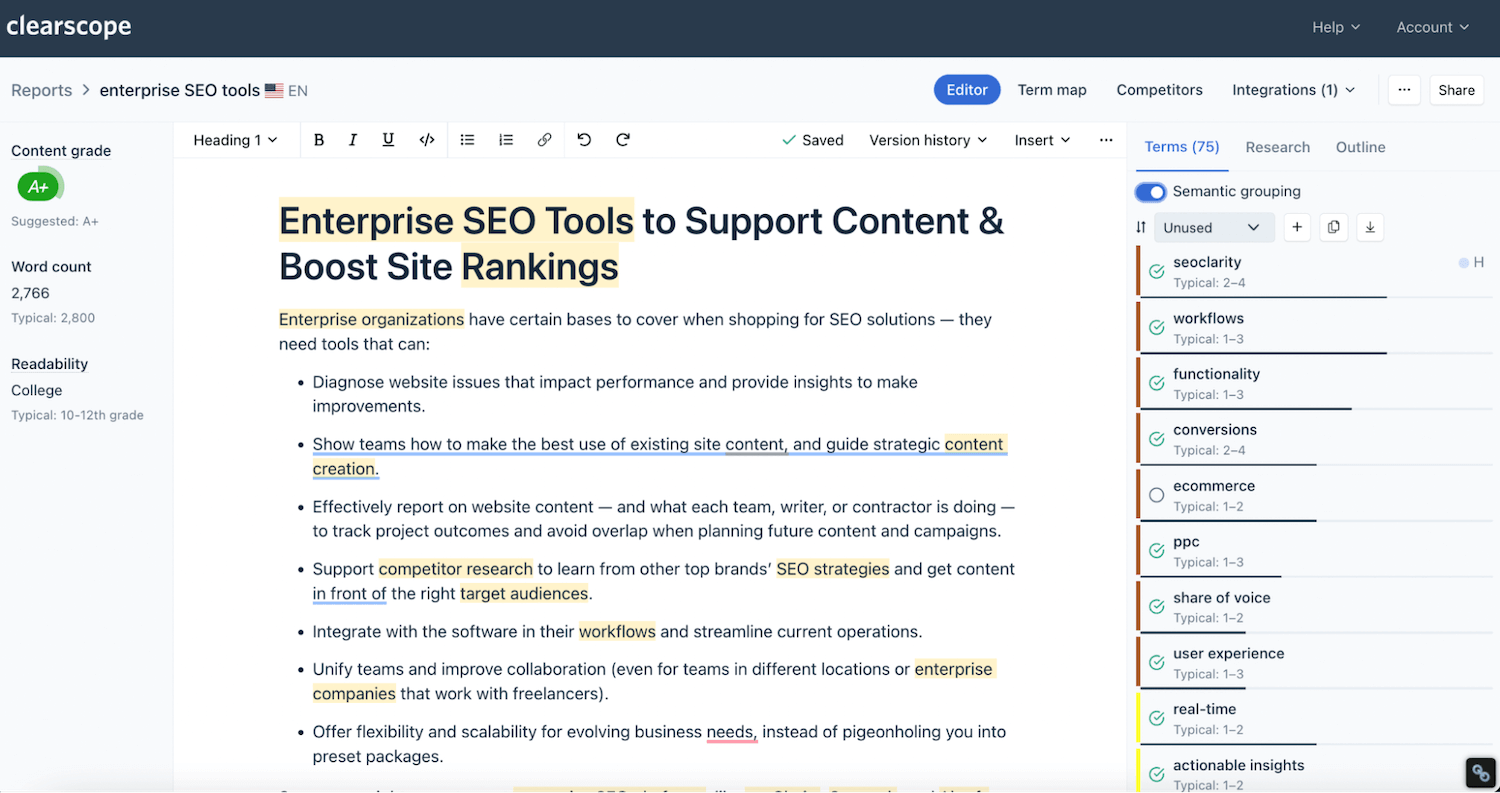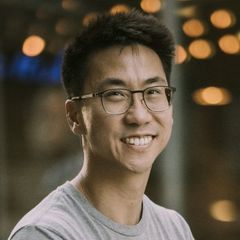
Table of Contents
Join our newsletter
Get access to trusted SEO education from the industry's best and brightest.
Writing content for SEO is not some super technical art. In fact, if you cater to search intent, cover relevant topics, answer common reader questions, and deliver on quality — chances are, your content already has a chance of ranking well (even before implementing any SEO best practices).
That’s because content quality — beyond just writing well, but honing in on what's important to the reader — is one of Google’s leading ranking factors. Even if you deploy a dozen other strategies to promote content, it won’t stay in top search positions or perform well if it isn’t carefully written and focused on readers’ interests.
The best and easiest way to produce optimized content is to weave SEO best practices into your natural writing processes. Understanding how to write for humans and Google means you can consider both audiences through every stage of content creation: from SERP research to editing and finalizing content.
Plus, SEO content writing solutions, like Clearscope, are designed to guide this very process. Our content optimization platform has:
Keyword research tools to perform SERP analysis and understand search intent.
Guided SEO reports that show you topics to cover, FAQs to answer, and important headings and terms to include in content.
Integrations with Google Docs and WordPress, so you can access SEO reports in the tools you already use to write and refresh content.
Our reports are designed to support natural, high-quality writing — we don’t overload you with hundreds of keywords to squeeze in content, and our platform uses natural language processing to understand variations of terms and phrases. Reports display real-time progress so you know which boxes you’ve checked and the readability status as you work.
In this post, we’ll review the best practices for writing SEO content within the context of your natural workflows — with Clearscope’s guided reports — and by the end, you’ll know how to write SEO-friendly content like a pro.
In summary, you want to:
Research the target keyword and understand how to cater content to search intent.
Brainstorm clear but catchy titles, meta descriptions, and headings that include relevant keywords.
Draft content while weaving in Clearscope suggestions, like recommended terms and FAQs.
Edit content for readability and scannability.
Add internal links, external links, supporting media, and alt-text.
Bonus: Build backlinks and use other promotional strategies to push content higher in search engine rankings.
You can also schedule a demo of Clearscope to learn more about our platform features and content reports. (Or try our platform here.)
1. Research the target keyword and SERP competitors to learn more about your audiences’ search intent
This first step is arguably the most important because everything after — the outline you put together, the content you cover, the images, links, and CTAs you include, etc. — is based on the research you gather here. (So it’s important to be thorough.)
Vetting the target keyword helps you understand who you’re competing with on the search engine results page (SERP) and learn about the target audience’s search intent.
This is the time to dig into search results and center yourself in the reader’s shoes:
What is the goal of their research? (Are they learning about a topic, shopping for a product or service, comparing two products/brands…)
What questions do they have? (Look at “People Also Ask” and the related searches.)
What sites are currently ranking? (Media outlets, medical sites, product pages, review sites, social media channels…)
What do they have to say on the topic? (What type of content do they produce? What do they do well? Where do they lack?)
Where do you fit in?
Analyzing competitors is beneficial because it gives you an idea of what they do well, and where their content is lacking, which can help you brainstorm strategies to outperform them in search engine rankings.
Remember to keep the readers’ goals at top of mind when putting together your outline — it’s crucial to understand what they’re looking for and cover that information in a clear, engaging way.
Clearscope simplifies this step because we provide resources to research the SERP within our platform.
First, generate a report for the target keyword — let’s say the primary keyword is “enterprise SEO tools.” Click the ‘Competitors’ tab within the report to see who’s ranking in the top #1-30 positions. We display page titles, URLs, content scores, and word counts for each page, then you can open links to see the actual content competitors provide.

You can also explore the ‘Research’ tab within reports to see themes, FAQs, and common citations to incorporate in your content. We also suggest searching the target keyword in a new window to see featured snippets and People Also Ask. (This can help with on-page SEO strategies later in our guide.)

This research shows that the Googler is learning about different types of enterprise SEO tools to determine what they need for their operations, and shopping popular options. So we’d want to educate the Googler on the variety of SEO tools, explain the purpose and benefits of each tool, and provide product recommendations for each category.
Once you wrap up this research, you should be in a comfortable position to begin outlining your piece of content.
You can read more about this step here: Your Guide to Analyzing User Intent for Better SEO Results
2. Outline your post so it has a clear, logical flow and strategic headings
Now is the time to assemble the bones of your post — there are a few goals at this stage.
First, you want to determine your positioning and write out the introduction. The key here is to get to the most valuable information as quickly as possible to interest readers, show them you’re on the same page, and keep them engaged with your website content.
If they’re looking for product recommendations, explain which products you’ll talk about and dive into the first suggestion; if they’re looking for steps to complete a task, set the expectations and get right into the “how-tos.” Don’t bore readers with irrelevant details or go on tangents explaining concepts they aren’t searching for.
It’s also helpful to add a table of contents in the intro to show readers what your content covers. Then they can see if your content appeals to their interests and skip to the section(s) they’re looking for.
Pro Tip: You can also incorporate a call to action in your intro to prompt reader engagement. For example, if a reader is shopping and comparing products, and you have a product to offer them, you could create a call-out in the intro promoting your solution and encourage readers to take the next steps with your brand.
Then, you want to draft your title and arrange your headings and subheadings. Some tips here:
Try to use the (exact) keyword in your page title. If you can’t incorporate the exact keyword, a variation of it also works. Just don’t completely overlook the keyword.
Be crafty with your SEO title tag and meta description — you want to persuade readers to select your content from the SERP, but you also need to include the keyword and meet length requirements. Catering these to both the reader and Google’s requirements can involve some creativity.
Use clear phrasing in headings so readers can scan through and understand what each section covers.
Use the main keyword and variations of it (long-tail keywords, related keywords) in headings — our SEO reports provide heading suggestions to help with this.
Use the recommended headers for different sections: H1 for your title, H2s for main sections, and H3s for subsections.
Clearscope’s SEO reports provide insights to help organize a clear, strategic outline.
As we mentioned, reports include heading suggestions, so you can see which terms and phrases to include in headings, but we also show you competitor’s outlines so you can identify commonalities and gather inspiration.

Read more: How To Write SEO Content Briefs and Outlines (Video + Template)
3. Draft your content and double-check that you’re fully covering each topic to answer reader questions
Once you’ve solidified your outline and know what you want to discuss from section to section, you can begin filling in your draft. Remember to focus on clear, value-driven details and provide well-rounded information about the topics you cover.
You should write in the same way you normally would: provide helpful information to satisfy user intent and pay attention to spelling, grammar, and readability. The end goal is still to produce high-quality content.
That said, Clearscope SEO reports provide suggestions to easily optimize content as you write — without compromising on quality.
Every report includes a list of recommended terms to include in your writing, and it’s easy to weave these in because we include mostly single-term suggestions and accept variations of keywords. (For example, if we suggest “content marketer” we’ll accept “content marketing.”)
We also tell you the significance of each term, so you know which ones are most important to include, and which aren’t as critical.

Our reports also have a “semantic grouping” button that will organize like-terms, so you can see how to weave in suggestions more naturally. Plus, we include definitions and examples with every recommendation so you can feel confident talking about new concepts.
Clearscope reports show your progress as you work, too, so you can see which terms you’ve included, the content score, and the readability level as you draft. And, as we mentioned earlier, we integrate with Google Docs and WordPress, so you can access reports in those tools and reference them as you draft or update website content.
It’s important to note: you want to use keywords in your content, but be careful of keyword stuffing. There’s no need to litter the keyword every place it might be applicable. Falling into this pitfall means quality suffers and content sounds robotic. Instead, use keywords where recommended (in the title or intro) and use other relevant keywords throughout.
4. Edit your content to weave in final recommendations and improve readability
After you wrap the rough draft, you can begin edits — and since the content is already mostly optimized, you can perform the edit as normal while considering any remaining report recommendations. (What is the overall content grade? Are there additional terms to include? How does your readability score compare to the average?)
Here are some best practices for this step:
Review the content for spelling and grammar issues, and consider the post's tone and flow.
Filter the Clearscope report by “Unused” to see any final suggestions and determine ways to improve the content score.
Edit for readability and scannability — readers may not stay engaged if your content isn’t easily scannable or it’s filled with long, hard-to-read sentences. (And time on page is another metric Google looks at to measure content quality and determine rank position.)
To improve readability, you should:
Use strategic bolding.
Explain complex processes or complicated concepts with bullet points.
Break long walls of text into shorter sections.
Rephrase wordy or confusing sentences.
In addition to Clearscope, you can also use a tool like Hemingway to identify hard-to-read sentences and make improvements.
Read more: 10-Step Checklist for SEO Content Editing (with Guided Reports)
5. Add the finishing touches before publishing
Once you finish editing your high-quality content, you can implement a few other on-page SEO strategies to hit on Google’s additional ranking criteria.
For example, content should include strategic links with smart anchor text and supporting visuals with complementary alt-text.
Adding these “extras” improves your credibility in Google’s eyes and supports the user experience — links give readers easy access to related resources on the topic they’re researching, and media can support content in unique ways.
When incorporating links in content:
1. Include both internal links and links to other (high-authority) sites.
Posts should include a handful of internal links and at least one external link. Make sure you’re linking to content that’s relevant to the topic so Google can see the relation.
On that note — it can be helpful to establish a “hub and spoke” structure within your content plan. For example, you write a handful of posts targeting similar topics, but one is the “hub” (or the most comprehensive, high-level post) and the others complement the main piece of content. Then, internal linking is mostly straightforward, and Googler’s crawler can see clear structure across your website content. Read more about topic clusters.
2. Check to confirm any site you link to has a high domain authority and can “boost” your content’s credibility.
This shows Google you’re citing accurate and reliable research during content creation, and referring readers to other experts on the subject. (Note that linking to sites with low DAs could actually have a negative impact.)
You can see domain scores in SEO tools like Ahrefs or Semrush.
3. Use keywords in anchor text, but also be clear about where the post is directing readers.
Readers should know what to expect from content before they hit the page. If anchor text is unclear, or directs readers to content they aren’t interested in, they’ll likely leave the page. (Which, again, could negatively impact content performance.)
Read more: 5 Effective Internal Linking Strategies to Improve Your SEO
Then, you should aim to include a handful of in-line media, like images, infographics, embedded videos, etc. Don’t go overboard with this, though — including too many images or stock images can clunk up content. Drop media where it truly supports content, and use some of our other strategies to improve readability in sections where in-line media doesn’t fit.
Don’t forget to include alt-text with in-line media, as well. Alt-text should clearly describe the media it corresponds with, so:
Google knows what the media contains.
Readers can view the alt text in instances where images don’t load.
Screen readers can identify alt text for searchers using assistive technologies.
To see an example, look at the alt text below the images in this post.
Note: Alt text also presents opportunities to weave in related keywords and additional terms from our SEO reports.
Once you check these final boxes, you’re ready to publish content and start monitoring its performance.
Extra SEO strategies to help you get on the first page of Google
After you publish, you should monitor rankings, organic traffic, and conversions for each piece of content to tell: a) where content is being found in search results, b) if readers are clicking on it, and c) if they’re engaging with you once they’re on your site. But there are also ways to improve content performance after it’s published.
First, you should build backlinks to site content — like external links, you should seek out link building opportunities from credible sites with high domain authorities, and in content where it makes sense to link to your site.
If your content hasn’t broken into the first page of search results, you can employ snippet optimization strategies to appear in the SERP above the list of organic results. For example, adding FAQs increases your chances of being pulled in the “People Also Ask” answers.
When including FAQs in content:
Use Clearscope’s research tab and reference questions in the SERP to brainstorm what’s valuable to add.
Keep answers concise — 3 to 5 sentences in length.
Use keywords in your questions and answers.
Read more: 12 Content Promotion Strategies To Strengthen Your Content Marketing
Then, to stay on the first page of Google, you need to monitor and periodically update content.
Clearscope has a “Content Inventory” tool where you can track all of your published web pages. Our platform is updated daily and keeps up with Google algorithm changes to report on your content’s current SEO scores. Then, you can see if content scores decline and plan updates to re-optimize web pages.

Monitoring content SEO scores helps you “get ahead” of updates and refresh content before you see it fall in rankings or traffic declines. (And refreshing content is easy — you can generate a new SEO report for the keyword, see what you’re missing, and know exactly how to make updates.)
Read more: How to Perform a Content Inventory & Audit (2023 Guide)
Getting started
The key to writing high-quality, SEO-friendly content is to follow SEO best practices in your existing writing workflows. You want to:
Write crafty, catchy page titles and meta descriptions with relevant keywords.
Use clear headings in outlines and weave related keywords where they fit.
Deliver value-driven copy that caters to search intent and provides in-depth explanations of the topics you cover.
Include strategic internal links, external links, and in-line media to support your content strategy.
Promote and monitor content so it can make it to the first page of search results (and stay there).
Clearscope’s content reports support every step of the writing journey. We show you how to optimize content without tacking on hours to your processes or impacting content quality; we provide suggestions to help you write titles and organize outlines, then show you the relevant terms and topics to include in your writing. You can use our tool to check SEO scores before publishing, then monitor content to maintain performance.
Plus, our platform is user-friendly, and all our reports are shareable: you can easily send SEO reports to your digital marketing team or freelance content writers so everyone you work with can integrate Clearscope into their writing workflows.
Schedule a demo with our team to see our features in action — or you can explore our packages and platform here.




